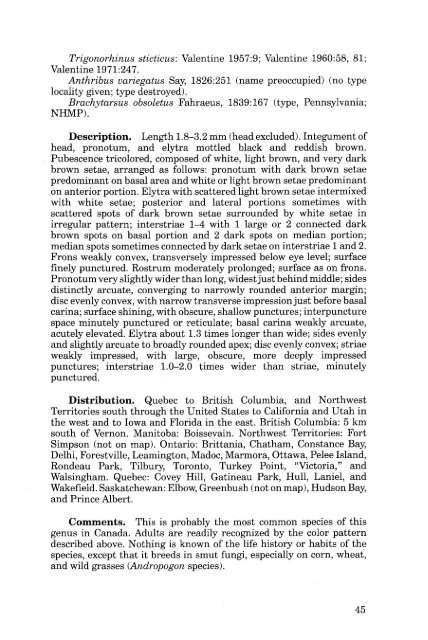Weevils - Entomological Society of Canada
Weevils - Entomological Society of Canada
Weevils - Entomological Society of Canada
Create successful ePaper yourself
Turn your PDF publications into a flip-book with our unique Google optimized e-Paper software.
Trigoruorhinus sticticus : Valentine 1957 :9 ; Valentine 1960 : 58, 81 ;<br />
Valentine l97L:247.<br />
Anthribus uariegatus Say, 1826:251 (name preoccupied) (no type<br />
locality given; type destroyed).<br />
Brachytarsus obsoletus Fahraeus, 1839:167 (type, Pennsylvania;<br />
NHMP).<br />
Description. Length 1.8-3.2 mm (head excluded). Integument <strong>of</strong><br />
head, pronotum, and elytra mottled black and reddish brown.<br />
Pubescence tricolored, composed <strong>of</strong> white, light brown, and very dark<br />
brown setae, arranged as follows: pronotum with dark brown setae<br />
predominant on basal area and white or light brown setae predominant<br />
on anterior portion. Elytra with scattered light brown setae intermixed<br />
with white setae; posterior and lateral portions sometimes with<br />
scattered spots <strong>of</strong> dark brown setae surrounded by white setae in<br />
irregular pattern; interstriae 1-4 with 1 large or 2 connected dark<br />
brown spots on basal portion and 2 dark spots on median portion;<br />
median spots sometimes connected by dark setae on interstriaet and2.<br />
Frons weakly convex, transversely impressed below eye level; surface<br />
finely punctured. Rostrum moderately prolonged; surface as on frons.<br />
Pronotum very slightly wider than long, widest just behind middle; sides<br />
distinctly arcuate, converging to narrowly rounded anterior margin;<br />
disc evenly convex, with narrow transverse impression just before basal<br />
carina; surface shining, with obscure, shallow punctures; interpuncture<br />
space minutely punctured or reticulate; basal carina weakly arcuate,<br />
acutely elevated. Elytra about l-.3 times longer than wide; sides evenly<br />
and slightly arcuate to broadly rounded apex; disc evenly convex; striae<br />
weakly impressed, with large, obscure, more deeply impressed<br />
punctures; interstriae I.0-2.0 times wider than striae, minutely<br />
punctured.<br />
Distribution. Quebec to British Columbia, and Northwest<br />
Territories south through the United States to California and Utah in<br />
the west and to Iowa and Florida in the east. British Columbia: 5 km<br />
south <strong>of</strong> Vernon. Manitoba: Boissevain. Northwest Territories: Fort<br />
Simpson (not on map). Ontario: Brittania, Chatham, Constance Bay,<br />
Delhi, Forestville, Leamington, Madoc, Marmora, Ottawa, Pelee Island,<br />
Rondeau Park, Tilbury Toronto, Turkey Point, "Victoria," and<br />
Walsingham. Quebec: Covey Hill, Gatineau Park, Hull, Laniel, and<br />
Wakefreld. Saskatchewan: Elbow, Greenbush (not on map), Hudson Bay,<br />
and Prince Albert.<br />
Comments. This is probably the most common species <strong>of</strong> this<br />
genus in <strong>Canada</strong>. Adults are readily recognized by the color pattern<br />
described above. Nothing is known <strong>of</strong> the life history or habits <strong>of</strong> the<br />
species, except that it breeds in smut fungr, especially on corn, wheat,<br />
and wild grasses (Andropogon species).<br />
45

















